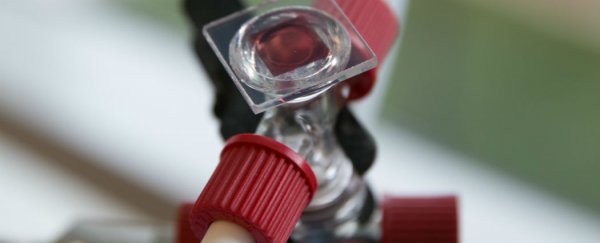By combining a solar cell and a battery into a single device, researchers in the US have made the first truly viable solar batteries. Not only can this battery compete with regular lithium-iodine batteries, it can actually outperform them, producing the same output with less charging, achieving an energy saving of 20 percent.
That 20 percent comes directly from sunlight, which is harvested by a flat solar panel on top of the battery. Below, the researchers have installed a new type of electrolyte that replaces the lithium-cobalt oxide or lithium iron phosphate of regular battery electrolytes with water.
"The truly important innovation here is that we've successfully demonstrated aqueous flow inside our solar battery," one of the team, Yiying Wu from Ohio State University, said in a press release. "It's also totally compatible with current battery technology, very easy to integrate with existing technology, environmentally friendly and easy to maintain."
The team is the same one that debuted the world's first solar air battery last year, and they've now improved on the design, by making the solar panel a solid sheet rather than a mesh, because it no longer needs air flow to function, and by adding the water-based electrolyte.
Called an aqueous solar flow battery, this world-first design could be the basis of an entirely new class of batteries, with or without the solar component installed. "In the original version, the researchers used a more conventional liquid electrolyte consisting of part salt and part solvent (perchlorate mixed with organic solvent dimethyl sulphoxide, to be precise)," Nick Lavars reports for Gizmag. "This has been replaced with water as the solvent and lithium iodide as the salt, which offers low-cost, high-energy storage capabilities."
The solar cell is also super-efficient, known as a dye-sensitised solar cell. The team used a red dye called ruthenium to tune the wavelength of light it captures and converts to electrons. According to the press release, these electrons are then used to supplement the voltage stored in the lithium-anode portion of the solar battery.
When they tested their solar batteries against conventional lithium-iodine batteries, they charged and discharged them 25 times to see how much electricity they would discharge each round. Each time, both batteries discharged around 3.3 volts. But as Lavars reports at Gizmag, while the typical battery needed to be charged to 3.6 volts to discharge 3.3 volts, the solar battery only needed to be charged to 2.9 volts, while the solar panel made up the other 20 percent.
The team now wants to work on increasing this percentage, and are working towards 100 percent energy savings, which would make it a fully solar-chargeable battery. But as they are, these solar batteries are already looking pretty damn practical.
"This solar flow battery design can potentially be applied for grid-scale solar energy conversion and storage, as well as producing 'electrolyte fuels' that might be used to power future electric vehicles," one of the team, doctoral student Mingzhe Yu, said in the press release.
The design is now patent pending, and the team reports the results of their testing in the Journal of the American Chemical Society.
